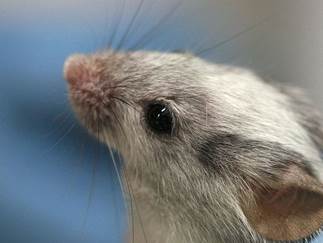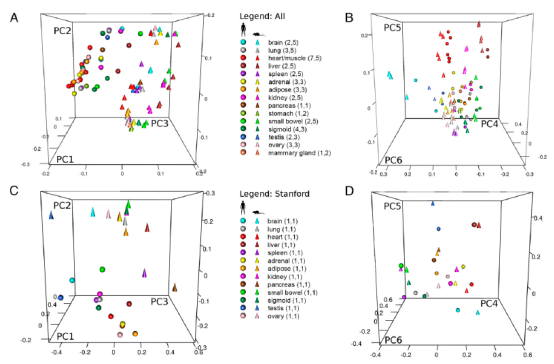小鼠模型须使用需谨慎
来源:《PNAS》
作者:Shin Lin
时间:2014-12-08


小鼠被广泛用于模拟人类代谢、疾病和药物应答,是医学研究中的一个基本工具。然而斯坦福大学的研究团队指出,人类和小鼠的基因表达存在着惊人的差异,不论是蛋白编码基因还是非编码基因。
Michael Snyder及其同事在15种组织中比较了人类和小鼠的基因表达情况,包括大脑、心脏、肝脏、肾脏等。他们发现,物种间的基因表达差异要大于组织间的差异。举例来说,小鼠肝脏与人类肝脏基因表达的相似性,要低于小鼠肝脏与小鼠心脏的相似性。这项研究使用了ENCODE、modENCODE等资源的RNA-seq数据,覆盖的组织类型更加全面。
“我们认为人类和小鼠在遗传学上非常类似,但它们的转录组差异其实很大,”耶鲁大学的生物信息学家Mark Gerstein评论道。
之前也有过类似的比较研究,不过它们得出了相反的结论。比如有研究指出,小鼠肝脏与人类肝脏基因表达的相似性,高于小鼠肝脏与小鼠大脑的相似性。Snyder认为,这些研究中的组织承担了互不相干的特殊功能,比如肾脏、睾丸、大脑、肝脏和肌肉。特异组织之间的显著差异导致“机体内的器官相似性没有得到充分的认识。”
Snyder及其同事在人类和小鼠中鉴定了四千多个差异性表达的基因。随后,他们分析了这些差异背后的表观遗传学改变(比如组蛋白修饰)。研究显示,当基因在某个物种高水平表达时,组蛋白H3K4me3和H3K27ac表现出更高的启动子活性。这说明小鼠和人类的基因表达差异是真实的生物学现象,不是实验或分析错误造成的。
研究人员还对非编码RNA进行了研究。他们发现,这些转录本在组织间的多样性要大于蛋白编码基因。大多数非编码转录本具有高度的组织特异性,不过要确定哪些转录本在组织间特异性表达还需要更多的数据。此外这项研究还证明,人和小鼠之间的调控信息(比如转录因子结合)存在着较大的差距。
“小鼠和人类的基因基本相同,但基因的表达模式有着不可忽视的差异,”Snyder说。这项研究可以告诉我们,使用小鼠模型在哪些方面更有帮助,在哪些方面需要谨慎。这些数据也有助于人们进一步理解小鼠和人类的基本生理区别。(来源:生物360)
Comparison of the transcriptional landscapes between human and mouse tissues
Abstract Although the similarities between humans and mice are typically highlighted, morphologically and genetically, there are many differences. To better understand these two species on a molecular level, we performed a comparison of the expression profiles of 15 tissues by deep RNA sequencing and examined the similarities and differences in the transcriptome for both protein-coding and -noncoding transcripts. Although commonalities are evident in the expression of tissue-specific genes between the two species, the expression for many sets of genes was found to be more similar in different tissues within the same species than between species. These findings were further corroborated by associated epigenetic histone mark analyses. We also find that many noncoding transcripts are expressed at a low level and are not detectable at appreciable levels across individuals. Moreover, the majority lack obvious sequence homologs between species, even when we restrict our attention to those which are most highly reproducible across biological replicates. Overall, our results indicate that there is considerable RNA expression diversity between humans and mice, well beyond what was described previously, likely reflecting the fundamental physiological differences between these two organisms.
原文链接:http://www.pnas.org/content/early/2014/11/19/1413624111.full.pdf+html




